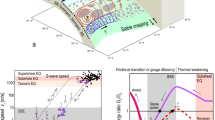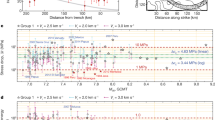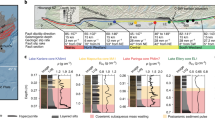Abstract
Understanding the earthquake rupture process is central to our understanding of fault systems and earthquake hazards. Multiple hypotheses concerning the nature of fault rupture have been proposed but no unifying theory has emerged1,2,3,4,5,6,7,8,9,10,11,12. The conceptual hypothesis most commonly cited is the cascade model for fault rupture1,3,10,13. In the cascade model, slip initiates on a small fault patch and continues to rupture further across a fault plane as long as the conditions are favourable. Two fundamental implications of this domino-like theory are that small earthquakes begin in the same manner as large earthquakes and that the rupture process is not deterministic—that is, the size of the earthquake cannot be determined until the cessation of rupture. Here we show that the frequency content of radiated seismic energy within the first few seconds of rupture scales with the final magnitude of the event. We infer that the magnitude of an earthquake can therefore be estimated before the rupture is complete. This finding implies that the rupture process is to some degree deterministic and has implications for the physics of the rupture process.
This is a preview of subscription content, access via your institution
Access options
Subscribe to this journal
Receive 51 print issues and online access
$199.00 per year
only $3.90 per issue
Buy this article
- Purchase on Springer Link
- Instant access to full article PDF
Prices may be subject to local taxes which are calculated during checkout



Similar content being viewed by others
References
Brune, J. N. Implications of earthquake triggering and rupture propagation for earthquake prediction based on premonitory phenomena. J. Geophys. Res. 84, 2195–2198 (1979)
Fukao, Y. & Furumoto, M. Hierarchy in earthquake size distribution. Phys. Earth Planet. Inter. 37, 149–168 (1985)
Ellsworth, W. L. & Beroza, G. C. Seismic evidence for an earthquake nucleation phase. Science 268, 851–855 (1995)
Beroza, G. C. & Ellsworth, W. L. Properties of the seismic nucleation phase. Tectonophysics 261, 209–227 (1996)
Dodge, D. A., Beroza, G. C. & Ellsworth, W. L. Detailed observations of California foreshock sequences: Implications for the earthquake initiation process. J. Geophys. Res. 101, 22371–22392 (1996)
Mori, J. Rupture directivity and slip distribution of the M 4.3 foreshock to the 1992 Joshua Tree earthquake, Southern California. Bull. Seismol. Soc. Am. 86, 805–810 (1996)
Mori, J. & Kanamori, H. Initial rupture of earthquakes in the 1995 Ridgecrest, California sequence. Geophys. Res. Lett. 23, 2437–2440 (1996)
Singh, S. K. et al. Implications of a composite source model and seismic-wave attenuation for the observed simplicity of small earthquakes and reported duration of earthquake initiation phase. Bull. Seismol. Soc. Am. 88, 1171–1181 (1998)
Steacy, S. J. & McCloskey, J. What controls an earthquake's size? Results from a heterogeneous cellular automaton. Geophys. J. Int. 133, F11–F14 (1998)
Kilb, D. & Gomberg, J. The initial subevent of the 1994 Northridge, California, earthquake: Is earthquake size predictable? J. Seismol. 3, 409–420 (1999)
Sato, T. & Kanamori, H. Beginning of earthquakes modeled with the Griffith's fracture criterion. Bull. Seismol. Soc. Am. 89, 80–93 (1999)
Ohnaka, M. A physical scaling relation between the size of an earthquake and its nucleation zone size. Pure Appl. Geophys. 157, 2259–2282 (2000)
Ellsworth, W. L. & Beroza, G. C. Observation of the seismic nucleation phase in the Ridgecrest, California, earthquake sequence. Geophys. Res. Lett. 25, 401–404 (1998)
Kanamori, H. The energy release in great earthquakes. J. Geophys. Res. 82, 2981–2987 (1977)
Nakamura, Y. in Proc. 9th World Conf. Earthquake Eng. VII, 673–678 (1988).
Allen, R. M. & Kanamori, H. The potential for earthquake early warning in southern California. Science 300, 786–789 (2003)
Kanamori, H. The diversity of the physics of earthquakes. Proc. Jpn. Acad. B 80, 297–316 (2004)
Nakamura, Y. in Proc. 13th World Conf. Earthquake Eng. Paper No. 908 (2004).
Lockman, A. & Allen, R. M. Single station earthquake characterization for early warning. Bull. Seismol. Soc. Am. (in the press)
Abercrombie, R. & Mori, J. Local observations of the onset of a large earthquake: 28 June 1992 Landers, California. Bull. Seismol. Soc. Am. 84, 725–734 (1994)
Eberhart-Phillips, D. et al. The 2002 Denali Fault Earthquake, Alaska: A large magnitude, slip-partitioned event. Science 300, 1113–1118 (2003)
Nielsen, S. B. & Olsen, K. B. Constraints on stress and friction from dynamic rupture models of the 1994 Northridge, California, earthquake. Pure Appl. Geophys. 157, 2029–2046 (2000)
Oglesby, D. D. & Day, S. M. Stochastic fault stress: Implications for fault dynamics and ground motion. Bull. Seismol. Soc. Am. 92, 3006–3021 (2002)
Das, S. & Scholz, C. H. Why large earthquakes do not nucleate at shallow depths. Nature 305, 621–623 (1983)
Mai, P. M., Spudich, P. & Boatwright, J. Hypocenter locations in finite-source rupture models. Bull. Seismol. Soc. Am. 95, 965–980 (2005)
Kanamori, H., Maechling, P. & Hauksson, E. Continuous monitoring of ground-motion parameters. Bull. Seismol. Soc. Am. 89, 311–316 (1999)
Somerville, P., Irikura, K., Graves, R. P., Sawada, S. & Wald, D. Characterizing crustal earthquake slip models for the prediction of strong motion. Seismol. Res. Lett. 70, 59–80 (1999)
Wells, D. L. & Coppersmith, K. J. New empirical relationships among magnitude, rupture length, rupture width, rupture area, and surface displacement. Bull. Seismol. Soc. Am. 84, 974–1002 (1994)
Acknowledgements
We thank H. Kanamori and S. Nielsen for discussions, and Y.-M. Wu and R. Hansen for making waveform data available for the study. The manuscript was improved by comments from R. Abercrombie and C. Scholz. Funding for this work was provided by the US Geological Survey NEHRP programme, the University of Wisconsin, Madison, and the University of California, Berkeley.
Author information
Authors and Affiliations
Corresponding author
Ethics declarations
Competing interests
Reprints and permissions information is available at npg.nature.com/reprintsandpermissions. The authors declare no competing financial interests.
Supplementary information
Supplementary Table 1
Earthquakes included in this study. (PDF 175 kb)
Rights and permissions
About this article
Cite this article
Olson, E., Allen, R. The deterministic nature of earthquake rupture. Nature 438, 212–215 (2005). https://doi.org/10.1038/nature04214
Received:
Accepted:
Issue Date:
DOI: https://doi.org/10.1038/nature04214
This article is cited by
-
Research on Interference Signal Recognition in P Wave Pickup and Magnitude Estimation
Geotechnical and Geological Engineering (2024)
-
Site class based seismic magnitude prediction equations for earthquake early warning
Journal of Seismology (2024)
-
Dynamic nucleation as a cascade-up of earthquakes depending on rupture propagation velocity
Earth, Planets and Space (2023)
-
Identification and statistical characteristics of foreshock sequences in the North–South seismic belt
Journal of Seismology (2022)
-
Earthquake Genesis and Earthquake Early Warning Systems: Challenges and a Way Forward
Surveys in Geophysics (2022)
Comments
By submitting a comment you agree to abide by our Terms and Community Guidelines. If you find something abusive or that does not comply with our terms or guidelines please flag it as inappropriate.



